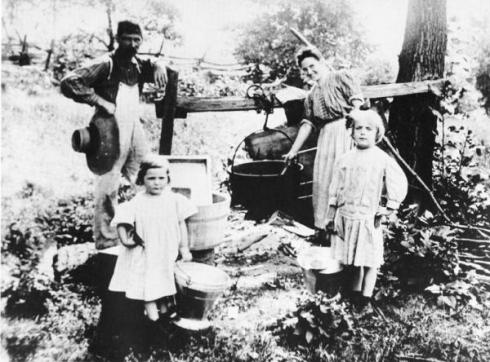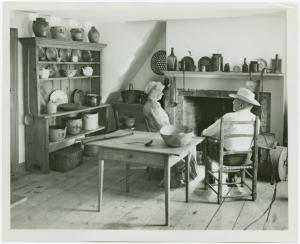
1890 Wash Day photo from http://www.explorepahistory.com
 Picture from the New York Public Library – woman and man sit in Walt Whitman farmhouse kitchen
Picture from the New York Public Library – woman and man sit in Walt Whitman farmhouse kitchen
Before I venture on to The Hoosier Cabinet, I wanted to take a look at a typical kitchen and what a woman’s life was like in 1890.
Respectability was measured by cleanliness. For the turn-of-century woman appearances were everything: hands, faces, outer clothing, doorsteps and entrances were suppose to be kept spotless, as were reputations.
Women who worked on the farm had a damn hard life – canning, butchering, sewing and mending, baking and cooking, keeping the stove hot all day, laundering, sweeping the chimney, filling the gas and oil lamps, hauling water and tending the garden and the children. Before modern detergents it could take a day to clean one room thoroughly. Laundry work took up 3 – 4 days every fortnight. Give me a break! It’s no wonder 47 was considered old age!
Leisure time for a wife at least was at a premium and religion could play a large part, with many Methodists for example expected to attend chapel twice a day on a Sunday and at least one class during the week. This was often impossible in a larger family (many women were pregnant on average every 18 months and 8 – 10 children were not uncommon with 2 – 3 probably dead in their early years) were most women (unless they could afford a nurse) were almost continually nursing a baby or sick child.
Although rather hidden, evidence is slowly emerging that many women of the time were often ill or depressed (no frickin wonder) for much of their lives, with only minimal treatments available.
The middle class had it a bit easier – maybe a servant or two, a wet sink, a cook stove, ice-chest refrigeration [1890-1922]. By 1915
electric refrigeration furnished the homes of the wealthy, but the middle-class would not see truly modern refrigerators until 1922.
A perfect sized Victorian (which I consider a upper-middle class) kitchen was thought to be 15′ X 17′. Big enough for movement but not too large. It contained a sink, stove, tables, dresser and hopefully connected to a pantry, cold room or a cellar.
Hard wood floors, washable or tiled surfaces, an iron sink, a portable stove rather than a set range, additional tables and a pump or running water were things every home maker yearn for.
Below is a photo of a woman’s tenement kitchen.
In 1863, New York City conducted the first sanitary survey. New York’s Association for the Improvement of the Condition of the Poor (est. 1844) finds “dark, contracted, ill constructed, badly ventilated and disgustingly filthy” housing. Some 18,000 people live in cellar apartments whose floors are putrid mud.”
While doing research for this post I feel nauseous. The more I read, the more disgusted I am. Woman had no rights, no votes and I’m moving on to The Hoosier Cabinet before I throw up.





January 5th, 2014 at 6:04 PM
Do you know anything about Hoosier cabinets with Roosters on or designed into the wood? I would love any information you could share
August 24th, 2013 at 1:54 PM
I want one!
June 20th, 2013 at 2:37 PM
I have an original Hoosier that is still in amazing condition, it isn’t doing anyone any good just sitting in my store, would you know of a good home for it?
June 21st, 2013 at 4:28 AM
Ali…What part of the country are you in and have any pics?
June 21st, 2013 at 8:35 AM
I am from Illinois…I do have pictures..I have it listed on craigslist an my store has a facebook page if you would like to check that out. http://www.facebook.com/pikecountytradingcompany. Or I can send pictures via email.